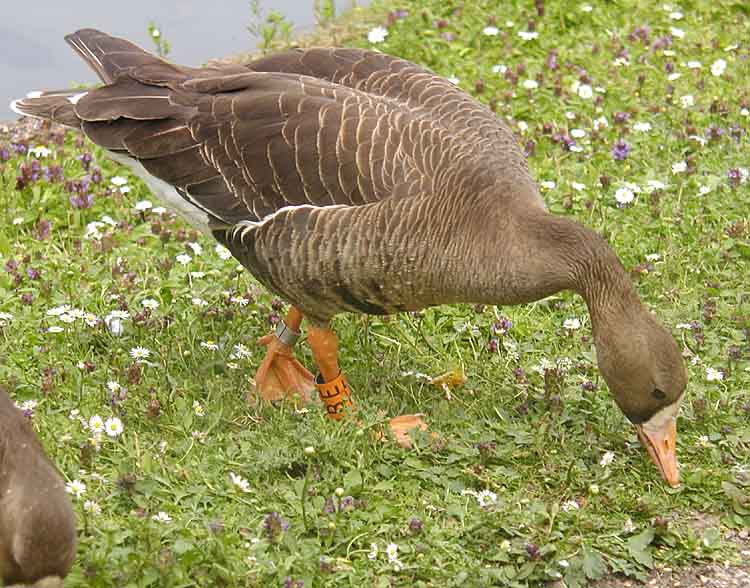|
| 질의: anser albifrons flavirostris | 결과: 3번째/4 | |
Greater White-fronted Goose (Anser albifrons) - Wiki
| 제목: | Greater White-fronted Goose (Anser albifrons) - Wiki
| |

| 해상도: 750x588
파일크기: 85019 Bytes
촬영일: 0000:00:00 00:00:00
사진기: C3100Z,C3020Z (OLYMPUS OPTICAL CO.,LTD)
F number: f/2.8
Exposure: 10/4000 sec
Focal Length: 191/10
등록시간: 2008:01:07 09:23:06
|
Greater White-fronted Goose
From Wikipedia, the free encyclopedia
Order: Anseriformes
Family: Anatidae
[Photo] European White-fronted Goose, Anser albifrons albifrons at Slimbridge Wildfowl and Wetlands Centre, Gloucestershire, England. Strangely, the White-fronted Goose does not have a white front!! Taken by Adrian Pingstone (http://commons.wikimedia.org/wiki/User:Arpingstone) in June 2003 and released to the public domain.
The Greater White-fronted Goose (Anser albifrons) is a goose species closely related to the smaller Lesser White-fronted Goose (Anser erythropus). In Europe it has been known as simply "White-fronted Goose"; in North America it is known as the Greater White-fronted Goose (or "Greater Whitefront"), and this name is also increasingly adopted internationally. In Northern and Central North America, it is colloquially called "Specklebelly" due to the salt-and-pepper appearance of the underside.
Description
Greater Whitefronts are 65-78 cm in length and have a 130-165 cm wingspan. They have bright orange legs and mouse-coloured upper wing-coverts. They are smaller than Greylag Geese. As well as being larger than the Lesser White-fronted Goose, the Greater Whitefront lacks the yellow eye-ring of that species, and the white facial blaze does not extend upwards so far as in Lesser.
Both white-fronted species have a very conspicuous white face and broad black bars which cross the belly, though the last two characters are occasionally observable to some extent in the Greylag Goose, which, however, has the bill and legs flesh-coloured, and pale bluish-grey upper wing-coverts.
Subspecies, distribution and status
The Greater White-fronted Goose is divided into five subspecies. The nominate subspecies Anser albifrons albifrons breeds in the far north of Europe and Asia, and winters further south and west in Europe. In the far east of Siberia east to arctic Canada, it is replaced by Anser albifrons frontalis, slightly larger and with a marginally longer bill, wintering in the United States and Japan.
Two other restricted-range races occur slightly further south in northern North America; Anser albifrons gambeli in interior northwest Canada, slightly larger still and wintering on the U.S. Gulf Coast, and the doubtfully distinct (Carboneras, 1992) Anser albifrons elgasi (Tule Goose) in southwest Alaska, largest and longest-billed of all, wintering in California. All these races are similar in plumage, differing only in size.
Finally, the very distinct Greenland White-fronted Goose Anser albifrons flavirostris breeding in western Greenland, is much darker overall, with only a very narrow white tip to the tail (broader on the other races), more black barring on its belly, and usually has an orange (not pink) bill. It winters in Ireland and western Scotland.
Recent ecological studies suggest the Greenland birds should probably be considered a separate species from Anser albifrons. Of particular interest is its unusually long period of parental care and association, which may last several years and can include grandparenting, possibly uniquely among the Anseriformes.
In the British Isles, two races overwinter: Greenland birds in Scotland and Ireland, and Russian birds in England and Wales. They gather on farmland at favoured traditional sites, with a famous flock gathering at WWT Slimbridge, Gloucestershire, England.
Anser albifrons albifrons and Anser albifrons flavirostis are among the taxa to which the Agreement on the Conservation of African-Eurasian Migratory Waterbirds (AEWA) applies. The Tule White-fronted Goose is very rare and has been since the latter half of the 19th century, presumably it was affected by destruction of its wintering habitat due to human settlement.
http://en.wikipedia.org/wiki/Greater_White-fronted_Goose
| The text in this page is based on the copyrighted Wikipedia article shown in above URL. It is used under the GNU Free Documentation License. You may redistribute it, verbatim or modified, providing that you comply with the terms of the GFDL. |
|
 |

|

|
anser albifrons flavirostris
3/4 |

|
 |
^o^
동물그림창고 똑똑전화 누리집
^o^
|
|

